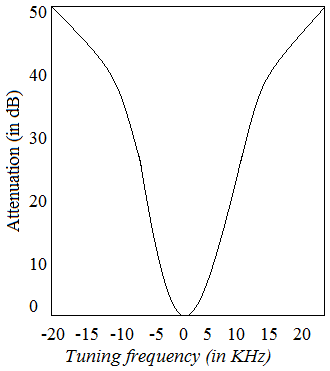Selectivity:
The selectivity of a receiver is defined as the ability to accept a given band of frequencies and reject all other unwanted frequencies is called its selectivity. It also express the attenuation that the receiver offers to signal at frequencies adjacent to the one to which it is tuned. In selectivity measurement, the frequency of the generators is varied to either side of the frequency to which the receiver is tuned naturally, the output of the receiver falls since the input frequency, is not incorrect. Thus the input voltage must be increased until the output is the same as it was originally. The ratio of the voltage required of resonance to the voltage. When the generator is tuned to the receiver frequency it is calculated at a number of points and then plotted in decibels to give a curve. The selectivity curve is shown in Figure 22.

Fig. 22 Attenuation versus frequency response of Sensitivity curve
Selectivity varies with receiving frequency and become somewhat worse when the receiving frequency is raised .In general, it is mainly determined by the response of the IF section .with the mixer and RF amplifier input circuits playing a small but significant part. Selectivity is the main factor which determines the adjacent channel rejection of a receiver.
Sensitivity:
The sensitivity of a radio receiver may be defined as its ability to amplify weak signals. It is generally .defined in terms of the voltage which must be applied at receiver input terminals to provide a stander output power measured at the output terminals. The signal to noise ratio and the power of the signals at output of the audio section are used to determine the quality of the signal received .for commercial AM broadcast receivers, a 10 dB or more signal to noise ratio with 500mV power at the output of the audio section is considered to be good. The minimum acceptable signal to noise ratio value for a broadband .microwave receiver is about 40dB with 5mW of signal power. The sensitivity curve is given in Figure 23.
 Fig. 23 Sensitivity versus frequency curve
Fig. 23 Sensitivity versus frequency curve
In selectivity, if the bandwidth is larger, between allow undesired signal to interfere with the desired signal. A receiver may be over-selective as well .This is also not desirable because an over-selective receiver cannot receive all component of the desired transmitted signal. The cut-off frequency is usually the 3dB frequency on both sides of the center frequency. 3dB frequency is a frequency point at which the output power falls to one-half of the maximum output power. The TRF receiver actually suffers from under and over-selectivity problem. To overcome this problem, the TRF receivers are finally replaced by super heterodyne receivers.
Fidelity:
The fidelity is an ability to reproduce all the modulating frequencies equally. The fidelity curve is shown in Figure 24. The high fidelity is essential in order to reproduce good quality music faithfully i.e. without introducing any distortion. For this, it is essential to have a flat frequency response over a wide range of audio frequencies. The fidelity curve is the basically frequency response of AF amplifier stage in the receiver. Ideally, the curve fidelity curve should be flat over the entire audio frequency range. But, practically, it decreases on the lower and higher frequency sides.

Fig. 24 Output power versus frequency response of Fidelity curve
